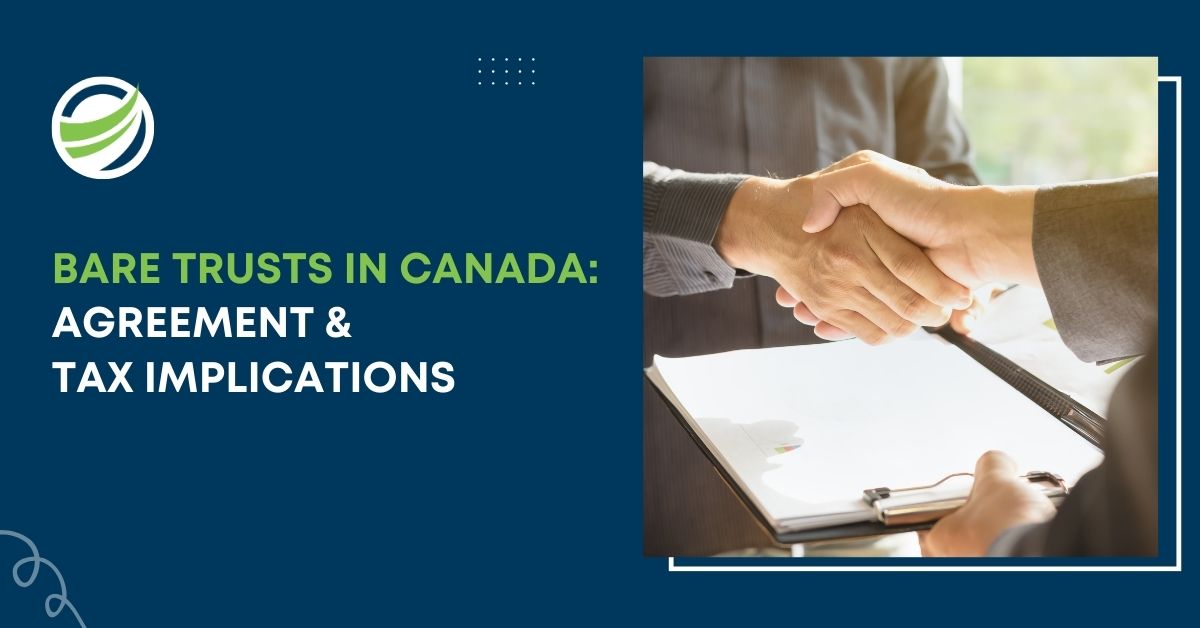If you’re navigating Canadian property ownership, investments, or estate planning, you may have come across the term bare trusts in Canada. Bare trusts are a unique legal arrangement that often flies under the radar but plays an important role in asset holding and tax planning. Understanding the bare trust tax implications and the details of a bare trust agreement are essential for anyone involved in this structure.
Did you know that simply co-signing your child’s mortgage could make you part of a bare trust and potentially subject to tax filing requirements? According to Global News, many Canadians are unaware that such everyday arrangements may come with complex tax implications. This blog explores what bare trusts are, how they work, and what you need to know in 2025.
What is a Bare Trust?
At its core, a bare trust is a simple legal arrangement where one party, the trustee, holds assets on behalf of another party, the beneficiary. Unlike other types of trusts, the trustee in a bare trust has very limited powers. They essentially act as a nominee or custodian. The beneficiary holds the full beneficial interest and can demand the property at any time.
A bare trust in Canada is sometimes referred to as a “nominee trust” or “simple trust,” and it’s commonly used in situations where legal ownership needs to be separate from beneficial ownership, but with minimal administrative complexity.

How Does a Bare Trust Work in Canada?
In a bare trust Canada setup, the trustee holds the title or legal ownership of the asset (such as real estate or shares) but must act strictly on the instructions of the beneficiary. The trustee does not have discretion over the asset; they cannot decide how to manage or dispose of it independently.
This makes bare trusts straightforward and transparent. The beneficiary keeps all the rights and responsibilities, including any income or capital gains from the asset. The trustee’s job is mostly paperwork and following directions.
Typical Uses of Bare Trusts in Canada
Bare trusts are popular for:
- Real estate transactions: Often, bare trusts are used to hold title to property on behalf of investors or family members, making transfers or financing simpler.
- Investment holding: Shares or securities can be held by a trustee to facilitate transactions without altering beneficial ownership.
- Estate planning: Bare trusts help manage and protect assets before transferring them fully to heirs.
- Business structuring: Some businesses use bare trusts to separate legal and beneficial ownership for liability or tax reasons.
Understanding the Bare Trust Agreement
A bare trust agreement is the backbone of the relationship between the trustee and beneficiary. Although relatively simple, this document should clearly outline:
- The identity of the trustee and beneficiary
- The nature and description of the property held
- The trustee’s limited duties: usually only to hold and transfer the property as directed
- Instructions on how and when the beneficiary can claim or dispose of the asset
- Terms for termination of the trust
Because bare trusts don’t give the trustee much power, the agreement is really about formalising the trustee’s role as a nominee.
Tax Implications of Bare Trusts in Canada
Given the nuances of bare trust tax implications and the recent shifts in CRA reporting rules, many Canadians are turning to outsourced tax help or expert professionals to ensure compliance and avoid costly oversights.
1. Income and Capital Gains
In a bare trust, all income (interest, dividends, rental income) and capital gains go straight to the beneficiary. That means the beneficiary must report these amounts on their personal or corporate tax return, depending on their situation.
Unlike discretionary trusts, bare trusts don’t pay tax themselves; the income “flows through” directly. This can make tax simpler, but it also means beneficiaries have to be diligent with their reporting.
2. Filing Requirements
When it comes to bare trust filing requirements, trustees usually don’t have to file trust tax returns, since the trust doesn’t earn or keep income. Instead, beneficiaries report income as if they directly owned the assets.
That said, trustees should keep clear records to prove the bare trust relationship if the CRA ever comes knocking.
As of October 29, 2024, the Canada Revenue Agency (CRA) announced that bare trusts are not required to file a T3 Income Tax and Information Return, including Schedule 15 (Beneficial Ownership Information of a Trust), for the 2023 and 2024 tax years, unless the CRA specifically requests it.
This update provides short-term relief to trustees who were previously unclear on their obligations, but it’s important to note that these exemptions are temporary and could change in future tax years.
3. Bare Trust Exemptions
In some cases, bare trusts may benefit from specific bare trust exemptions under Canadian tax law. For example, certain types of income or transactions may be exempt from specific withholding taxes or reporting requirements, especially in real estate or cross-border situations.
Understanding these exemptions can be a powerful tool for tax planning, but requires careful application and sometimes professional advice.
An Example: How a Bare Trust Works
Let’s make this real with a bare trust Canada example:
Suppose a family wants to hold a property in trust for a minor child. The parent acts as trustee, holding the title to the house but managing it strictly for the child’s benefit. The child, as beneficiary, has the right to the property and any income or proceeds from it once they come of age.
In this scenario:
- The parent (trustee) holds legal ownership but can’t sell or mortgage the property without the child’s consent.
- The child (beneficiary) is responsible for declaring any rental income or capital gains on their tax returns.
- The trust arrangement is formalised through a simple bare trust agreement.
The CRA’s abrupt announcement on March 28, 2024, exempting bare trusts from certain filing requirements, caught many Canadians off guard. As reported by Global News, this last-minute change led to significant frustration among taxpayers who had already prepared the necessary documentation, highlighting the challenges posed by sudden regulatory shifts.

Comparison With Other Trust Types
Bare trusts are quite different from discretionary or family trusts, where trustees have more say over income distribution and asset management. Because beneficial ownership in bare trusts is transparent and direct, there’s usually less tax and compliance complexity.
This makes bare trusts a great choice when you want simplicity and clarity, though they’re not ideal if you need flexibility or control over income distribution.
Whether it’s managing a family trust, co-signing a mortgage, or holding property on someone else’s behalf, financial services outsourcing allows Canadians to stay focused on their goals while experts handle the regulatory details. It’s important to note that not every co-signer is automatically part of a bare trust, this depends on the specific facts and the intentions of the parties involved.
Practical Tips for Trustees and Beneficiaries
If you’re involved in a bare trust, here are a few things to keep in mind:
- Always have a clear and signed bare trust agreement. Even simple arrangements benefit from a written agreement, as it reduces misunderstandings and legal risks.
- Keep detailed records of all transactions, instructions, and communications related to the trust assets. This helps meet any CRA requests and protects both trustee and beneficiary.
- Remember that bare trust tax implications mean beneficiaries need to be careful about reporting income and gains.
- If unsure about exemptions or run into complex situations, don’t hesitate to reach out to a tax professional or legal expert who knows trusts inside and out. Additionally, partnering with an outsourced bookkeeper can help ensure that detailed records, filings, and income reports are properly maintained for CRA purposes.
In March 2025, the Office of the Taxpayers’ Ombudsperson released a report titled “Unintended Consequences: Bare Trusts,” which criticised the timing and clarity of the CRA’s announcement.
Many Canadians were caught off guard by the late clarification that bare trusts would be exempt from filing in 2023 and 2024. The report stressed the need for earlier, clearer communication from the CRA to reduce unnecessary panic and paperwork.
Conclusion
Bare trusts in Canada remain a practical and straightforward tool in 2025 for holding assets while keeping beneficial ownership transparent. Understanding the essentials of a bare trust agreement and the related tax responsibilities involved is key to making the most of this arrangement without running into pitfalls.
Whether you’re dealing with real estate, investments, or estate planning, knowing how bare trusts operate and their tax implications will help you manage your financial affairs with confidence.
If you’re thinking about setting up a bare trust or want to see how it fits into your financial strategy, it’s always smart to consult qualified outsourcing tax professionals to make sure everything is done right.





